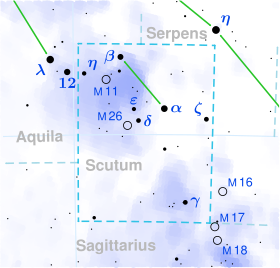Star in the constellation Scutum
Zeta Scuti , Latinized from ζ Scuti, is the Bayer designation for a star in the southern constellation of Scutum . It is a faint star but visible to the naked eye with an apparent magnitude of 4.66.[ 2] parallax measurement, is around 210 light years . It is moving closer to the Sun with a radial velocity of −5 km/s.[ 5]
This is an astrometric binary system with a period of 6.5 years (2,374 days) and an orbital eccentricity of 0.10.[ 3] giant star of type G with a stellar classification of G9 IIIb Fe−0.5.[ 3] spectrum displays a mild underabundance of iron. It has 1.29 times the mass of the Sun and has expanded to 9.3 times the Sun's radius .[ 7] [ 2] Sun's luminosity from its enlarged photosphere at an effective temperature of 4,750 K.[ 8]
References
^ a b c d e van Leeuwen, F. (November 2007), "Validation of the new Hipparcos reduction", Astronomy and Astrophysics , 474 (2): 653– 664, arXiv :0708.1752 Bibcode :2007A&A...474..653V , doi :10.1051/0004-6361:20078357 , S2CID 18759600 . ^ a b c d e f Anderson, E.; Francis, Ch. (2012). "XHIP: An extended hipparcos compilation". Astronomy Letters . 38 (5): 331. arXiv :1108.4971 Bibcode :2012AstL...38..331A . doi :10.1134/S1063773712050015 . S2CID 119257644 . Vizier catalog entry ^ a b c Eggleton, P. P.; Tokovinin, A. A. (September 2008), "A catalogue of multiplicity among bright stellar systems", Monthly Notices of the Royal Astronomical Society 389 (2): 869– 879, arXiv :0806.2878 Bibcode :2008MNRAS.389..869E , doi :10.1111/j.1365-2966.2008.13596.x S2CID 14878976 . ^ a b Mallama, A. (2014). "Sloan Magnitudes for the Brightest Stars". The Journal of the American Association of Variable Star Observers . 42 (2): 443. Bibcode :2014JAVSO..42..443M . Vizier catalog entry ^ a b Pourbaix, D.; Tokovinin, A. A.; Batten, A. H.; Fekel, F. C.; Hartkopf, W. I.; Levato, H.; Morrell, N. I.; Torres, G.; Udry, S. (2004). "SB9: The ninth catalogue of spectroscopic binary orbits". Astronomy and Astrophysics . 424 (2): 727– 732. arXiv :astro-ph/0406573 Bibcode :2004A&A...424..727P . doi :10.1051/0004-6361:20041213 . S2CID 119387088 . ^ Jancart, S. (2005). "Astrometric orbits of SB9 stars". Astronomy and Astrophysics . 442 (1): 365– 380. arXiv :astro-ph/0507695 Bibcode :2005A&A...442..365J . doi :10.1051/0004-6361:20053003 . S2CID 15123997 . ^ a b c d Allende Prieto, C.; Lambert, D. L. (1999). "Fundamental parameters of nearby stars from the comparison with evolutionary calculations: Masses, radii and effective temperatures". Astronomy and Astrophysics . 352 : 555– 562. arXiv :astro-ph/9911002 Bibcode :1999A&A...352..555A . Vizier catalog entry ^ a b Gontcharov, G. A. (2009). "Red giant clump in the Tycho-2 catalogue". Astronomy Letters . 34 (11): 785– 796. arXiv :1607.00619 Bibcode :2008AstL...34..785G . doi :10.1134/S1063773708110078 . S2CID 73524157 . Vizier catalog entry ^ De Medeiros, J. R.; Alves, S.; Udry, S.; Andersen, J.; Nordström, B.; Mayor, M. (2014). "A catalog of rotational and radial velocities for evolved stars". Astronomy & Astrophysics . 561 : A126. arXiv :1312.3474 Bibcode :2014A&A...561A.126D . doi :10.1051/0004-6361/201220762 . S2CID 54046583 . Vizier catalog entry
